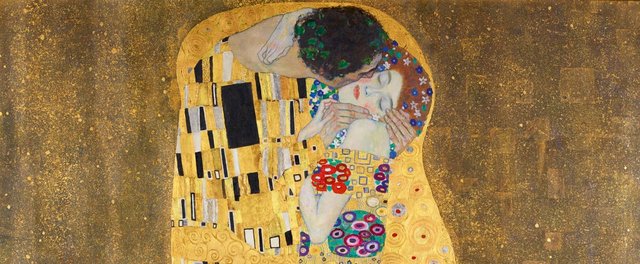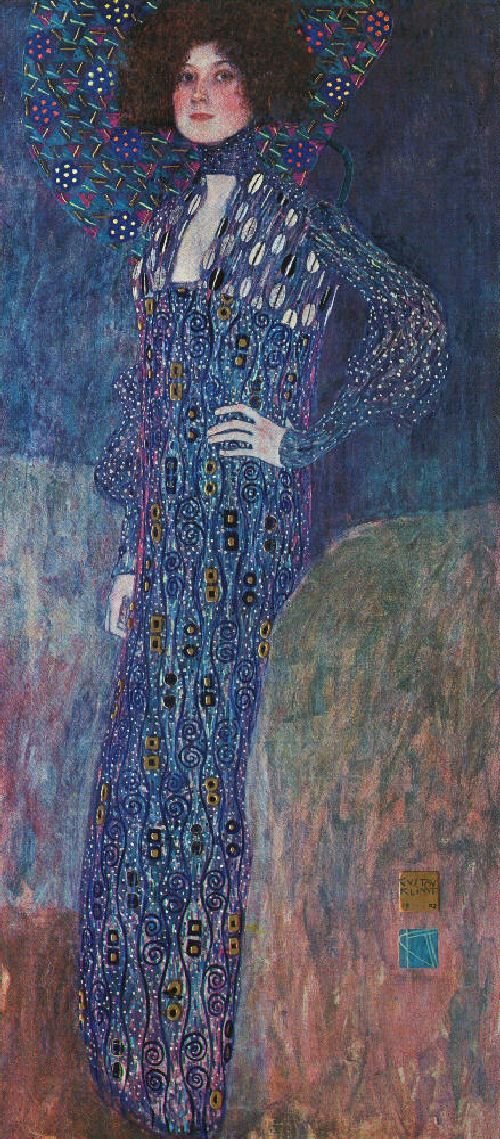/ Gustav Klimt / The Kiss (Lovers) /

In order to not be depended from the state, Klimt dedicated his career to painting portraits of ladies from Vienna from the early 20th century. He managed to portray the required dignity, while painting the Eros. Portraits were always satisfying because the beauty of the woman was never sanctioned, on the contrary, it was always very desirable and representative.
Klimt led multiple lives, or you could say he clearly drawn the boundaries between his studio, public appearance and his privacy. He avoided making any comments about himself and his life, and the most intriguing question about Klimt's privacy is the relationship with one woman.
In addition to numerous love affairs, Gustav Klimt had a special relationship with Emily, sister of Klimt's brother's widow and daughter of a Viennese industrialist throughout his lifetime. She was his student and model for the portrait, and later the owner of the successful Vienna fashion house designed by Klimt himself, contributing to the success Emilia achieved in the rich Viennese circles. The creations of Emili Flege are also immortalized on Klimt's paintings.
The details of their relationship are somewhat familiar to us through their correspondence, partially preserved. The duration of this correspondence and friendship lasted trough whole Klimt's life. And on the death bed, he asked to call her to be near him.

He painted portrait of Emily in 1902 in a dress she created and sewn on her own. The dress was cotton-knit, feminine and comfortable, straight down and narrowed around her leg, emphasizing and elongating the silhouette. The dress highlights Emile's slender figure, (for that time she was very avant-garde and totally different from fashion that was then worn). Over her, she had a bolero jacket with thin, airy sleeves that fitted with a dress, soft and bell-like to fall to the forearm and then fastened tightly around her arm. Emily followed the fashion trends and introduced the Vienna fashion reform gear. "Reform" implies a reformist movement in the women's fashion from the late 19th and early 20th centuries - the dresses were comfortable and wide enough in the waist to not have to wear a corset underneath them.
Klimt did the portrait not by order, but because he wanted to paint it. He intended to give it to Emily's mother, he did it, but she did not like it and kept it locked. After several years, he bought it from her and sold it to the Vienna Historical Museum in 1908.
If among them there was something more than friendship, reiterated from any other material proof of their love and the artist's emotions, one painting speaks everything. It is thought that Klimt's famous painting The Kiss from 1907/08, is an homage to their unusual connection and a reflection of his love with Emily. The first thing we notice is that the The Kiss is bathed in golden color and mosaic details, so much loved by Klimt (he painted it during his so-called golden period, when he used a lot of gold and gold leaf). This flame splendidly associates with blooming, life, joy, wealth and abundance, and strongly acts on the observer's senses.

The woman in the picture at first appears to be completely surrenders, the focus of the image is on her face that has a satisfied, stunned expression; this face has no individual characteristics. The woman is extremely feminine, erotic, gentle, calm, just frowning in embrace. A woman who melts in a hug is passive, an object of passion, letting herself be swayed. Her blond hair is covered with flowers, as if evokes love and spring, and the body is given only through a silhouette that is beautiful and appealing even for today's canons. There is no pronounced self-consciousness, no provocation, no relationship with the observer, but she is still in the main role.
Man's face can not be seen, there is no accent on him, but on the woman he holds in his embrace. His face is darker than hers, wearing a wreath of leaves - glory, spring, victory - on a strong male head. Something is seriously wrong with his neck, but it's impossible that Klimt didn't noticed that. It seems that the anatomical rules do not apply here, the strength of the male is emphasized. Another unusual detail in proportion is seen. He stands, she kneels, but when she gets up, she would be considerably higher than him. This detail reveals that Emili and Klimt are in front of us, because he was not a tall man and had a square body structure, and she was lean and visibly higher than him.
The painting came on to undivided enthusiastic reception by the audience. It has become an icon of two lovers, often perceived as a romantic show of passion. It is certain that its lyrical work came strongly on the observer. The Kiss did not only passed censorship, but the artist's work was finally recognized. And before the Art Exhibition on which The Kiss was exhibited in 1908 ended, the picture was bought by the state.
Note: This was my translation from Serbian to English from PULSE article ''Густав Климт, III део: Пољубац'' by Z.Antic
Klimt is great, we have "The Kiss" in our home.